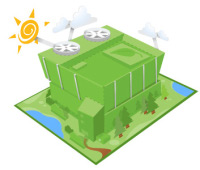 It’s true that cloud computing technology’s main appeal is the benefits it provides with regard to being cost effective and their ability to reduce a company’s environmental footprint, especially when compared to conventional data center farms. However, many industry experts are still wondering how to quantify these benefits and provide a more accurate, or at least consistent readings of the cloud’s impact and benefits.
It’s true that cloud computing technology’s main appeal is the benefits it provides with regard to being cost effective and their ability to reduce a company’s environmental footprint, especially when compared to conventional data center farms. However, many industry experts are still wondering how to quantify these benefits and provide a more accurate, or at least consistent readings of the cloud’s impact and benefits.
Enter the researchers at the Lawrence Berkeley National Laboratory, who have managed to devise a model for quantifying the carbon footprint and energy use of cloud computing. Unsurprisingly, the project is funded by one of the largest names in cloud computing technology, Google. Google obviously has an interest in the promotion of cloud technology, as they run some of the most popular cloud computing services in the industry. Other key players include Oracle, HP, and Amazon – all of which are looking into more ways to use renewable energy for their growing server farms.
The model basically concludes that moving common applications and code, such as email, spreadsheets, and CRM software to the cloud will save the same amount of electricity needed to power Los Angeles. According to their report, the amount of energy that can be saved is 87%, or roughly 23 billion kwh.
The main reason for the savings in electricity is because businesses who rely on the cloud no longer need to build and run large server farms on their own locations, as they can take advantage of the cloud for their storage and computing needs. The cloud provider, on the other hand, handles the storage and computing needs of multiple businesses, ensuring that the companies are only using what they need, and no resources are left idle or unused. Additionally, cloud service providers can also build their datacenters in places where there are renewable or more environment-friendly sources of energy.
While most cloud service providers are all too willing to calculate the savings that they will bring to their consumers, the model used by Berkeley Lab’s researchers are more credible as they have no vested interest in selling cloud services to consumers, and that their method is more sophisticated and transparent.
Their model essentially takes into account the carbon emissions and energy use not just of the data centers but includes the use of electric grid, electronic devices, and transportation that will help in the use of the cloud. The main purpose of the model is for businesses to use it for assessing the energy savings they’ll get via cloud service compared to how much they would be spending if they were running their own servers.
Europe in general is very concerned about reducing energy use and carbon footprint, which is why there are many projects being funded in the region that look at how data centers can be run more efficiently. One of the key hurdles is the lack of standards when it comes to measuring and analyzing energy savings, and The Berkely Lab’s model is currently the closest one they’ll get to a transparent and efficient method.